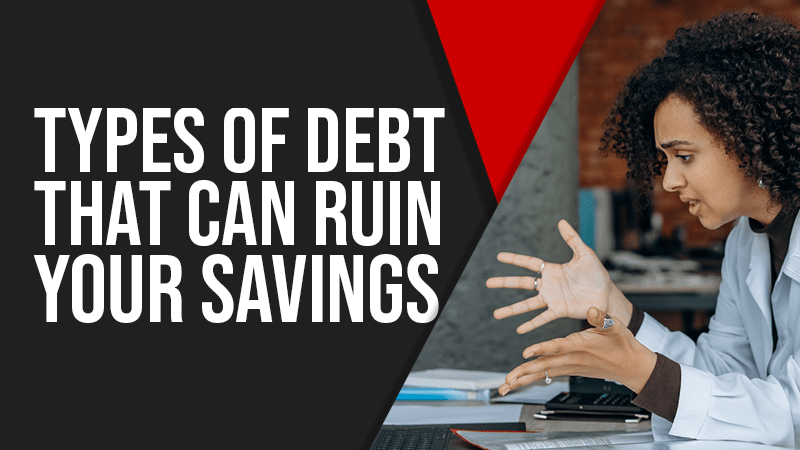4 Usual Types of Debt That Can Ruin Your Savings
Share this content :

In a perfect world, everyone could pay off their purchases right away. Unfortunately, we live in a world where paying in full is difficult. The best alternative is to use a loan or debt to get you what you need. All of us have gone into debt. Whether buying a new car or funding a business, we build up dues over time.
What’s dangerous about debt is that it can take a massive bite at your savings. Paying off your bills for credit cards, student loans, and other charges can get costly. With the right mindset and strategy, you can keep yourself from losing everything in your wallet. Here’s what you need to know about different types of debt and how they can challenge your financial plans.
Explaining Debt
For those who don’t know, debt is borrowing money and promising to pay it later. It’s a common tactic in finance. Banks, government agencies, and even well-earning individuals use debts as investments. They can slowly earn back their cash over time by paying for their needs. That’s why debts come with interest rates as a way to pay back those that you owe.
What surprises people is how easily debt builds up in our lives. We all develop a loan of some sort, either for our expense or professional reasons. For example, businesses borrow money from banks to kickstart their projects and gain customers. In return, these businesses slowly pay back the banks over an agreed amount of time. Popular types of debt that you’ve probably heard of include student loans and credit.
You can simplify all types of debt into two categories: secured and unsecured. Understanding the difference between the two can help you pick the right option when you need more money.

Secured Debt
Secured debts are loans that include some type of asset as collateral. For example, mortgages act as payments for buying a house or a lot. If the one who owes money can longer pay, the lender can collect the property as their compensation. In other words, secured debts include an asset you must pay for. If you don’t pay it, you risk losing your purchase and the item in question.
Keep in mind that secured debts usually go through a vetting process. This process allows the lender to examine the client’s capacity to pay them back. In other words, they will check you carefully to see if you can use their money correctly. Other examples of secured debt include auto loans and stock investments.
Unsecured Debt
In contrast to the type above, unsecured debts don’t have any assets to collect. The lender essentially has to trust the customer in paying back their dues. Because there’s no collateral, lenders providing unsecured debt use higher interest rates and contracts.
Those who cannot pay back are then likely to be sued. Since unsecured credit relies on the customer’s trustworthiness, banks typically apply this through a credit score. This score shows how consistently a person pays their loans or bills on time. The higher the score, the higher the amount you can borrow or use
An example of unsecured debt is gym memberships. These contracts only provide the service and access to gym equipment. If you can’t make your payments, your membership gets revoked, and you’ll be required to pay any outstanding costs. Other examples of unsecured debt include credit cards and student loans.
The Four Most Common Types of Debt
The following four types of debt are the most common in the US today. You will most likely encounter these at some point in your life.
Studies have shown that these four types have garnered trillions of dollars in value in the country.
1. Mortgages
The highest and most used debt is a mortgage, which is the money loaned to potential homeowners. These people use mortgages to buy new lots or households. As of 2021, mortgage debts in the US have grown to over $10 trillion in value. Aside from cash, people have pledged other types of assets to pay off their mortgages. Collateral options have included stocks, vehicles, and other lots or properties.
2. Student Loans
The second highest value debt is student loans, valued at $1.54 trillion in 2021. This type of debt occurs when people loan from banks or federal agencies to pay for higher education. Those who attend college, university, or technical schools use these loans to cover their living expenses and books. Other costs that student loans cover include tuition fees, travel expenses, and materials for higher learning.
3. Auto Loans
Auto loans are the third-highest and most common debt, standing behind student loans at 1.42 trillion. Auto loans cover purchases and maintenance of cars. Compared to personal loans, this type of debt uses the car as collateral. In other words, those who cannot repay their lenders lose their car instead. On the plus side, having collateral means that the lender typically uses lower interest rates for their fees.
4. Credit Card Debt
The fourth highest debt in 2021 is credit card debt, at approximately $800 billion. Credit card debt covers the limits and use of credit cards for various consumers. Usually, the amount a person can use as credit relates directly to their score, as determined by the bank. Improving your score requires timely payments and consistent use of your credit card. The things that can drag down this score include outstanding balances, overuse or underuse of the card, and multiple inquiries about your score and payments.

Three Ways Your Debts Are Hurting Your Savings
Now that you know the four highest types of debt nationwide, it’s time to explain how you can pay them off quickly. The problem with these debts is that they can cost a lot, depending on their interest and frequency. Here’s how your debts can be hurting you and your savings.
Debt Limits Your Financial Goals
When you check your expenses, debts will take up a large portion of your income. Paying all those fees will keep you from reaching your financial goals. For example, you might be trying to save to buy a new car. However, if you’re busy paying for your current vehicle and other expenses, it might take a long while to do so. Another issue is that your priorities focus more on paying off than exploring new ventures. It could take years before you feel secure enough to try investing or starting a side hustle you enjoy.
Debt Increases Your Stress
Concern about your all types of debt, while valid, can make you feel nervous and unsure. You might keep looking at your wallet and wondering how much you’ll lose by next month. That kind of anxiety can be debilitating, especially if you’re unsure how to divide your money correctly.
Debt Damages Your Credit Score
Outstanding bills, including debt, will affect your credit score. Because you have other payments you owe, the lenders may not give you the options you want. For example, a bank may not trust you enough to provide you money if you’re going to buy a house but have large student loans. In other words, debt can keep you from making more payments and necessary loans in the future.
Five Tricks to Pay Off Debts Faster
A practical action plan can help you cover these expenses and retain your house or car. Alternatively, it can ease your debt’s effect on plans for investment or purchases. Imagine being able to buy something without worrying about your student loans. You’ll be able to spend more and feel better about yourself. To help, here are five tricks for paying off all types of debt faster.
1. Prioritize Your Debts
Knowing which to pay off first might seem obvious. Most people think of using their money to remove the debt with the highest interest rate. However, this tactic isn’t very effective. Even a debt with low interest can be the most pressing or important one to pay. Instead of focusing on the highest number, consider which debt is the most crucial to pay off. For example, which debt seems most harmful to your credit score? Outstanding credit card bills can cause banks to trust you less. Removing it fast allows you to get a good enough score to negotiate new loans and rates.
2. Paying Over Minimum
One of the fastest ways to pay off various types of debt is by going beyond the minimum fee. Adding an extra hundred dollars can make that 20-year agreement into a 15, 14, or even 12-year deal. Remember that adding more cash to your fee should come from money you won’t need for other funds. I strongly disagree if you’re considering using your retirement savings to pay off the cash.
3. Ask for Lower Interest Rates
Reducing the percentage of interest is an excellent way to reduce your fees and make payments more manageable. You might think creditors would refuse to negotiate, but that’s not true! They’ll reconsider the rate if you have a good relationship with your creditors. As long as your transaction history and timely payments are good, they’ll talk to you about reducing the interest rate.
4. Extra Income
What better way to pay off different types of debt than with more money? Seriously though, an extra job or a sideline gig can be the solution you need. I recommend choosing hobbies you love or seasonal jobs near your workplace as starting points. For example, those who enjoy baking can make extra cash by selling homemade pastries. You’ll need to work harder, but it could be a worthwhile venture.
If an extra job sounds too tricky, you can try and sell things that you don’t need. Unused clothes or old toys can be helpful at a garage sale. Not only can you earn more money, but you’ll also declutter your room.

5. Adjust Your Budget Plan
Sometimes, what’s holding you back is that you’re spending too much. You might spend more than necessary on other things, like snacks or clothing. I suggest reviewing your current budget plan to fix this and pay all types of debt. Map out your expenses based on their type, cost, and importance. You might discover some payments that you don’t need to make. If you shift them from fun money to debt money, you can clear out your loans and have peace of mind.
Now you know what are the types of debt that can ruin your savings, you can now avoid toxic debt traps
Share this content :
Copyright © 2023 Munif Ali. All rights reserved.

